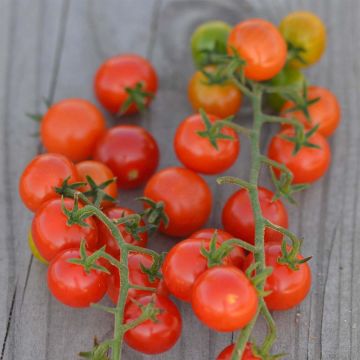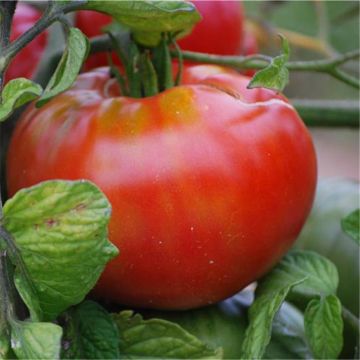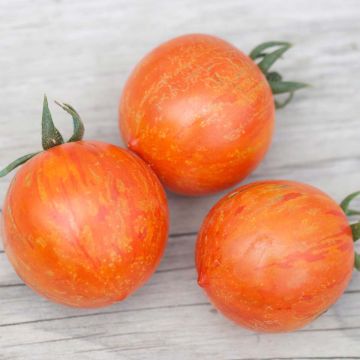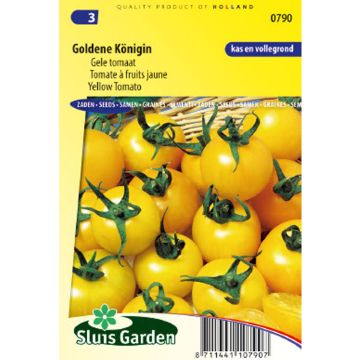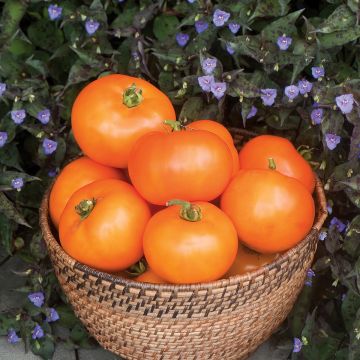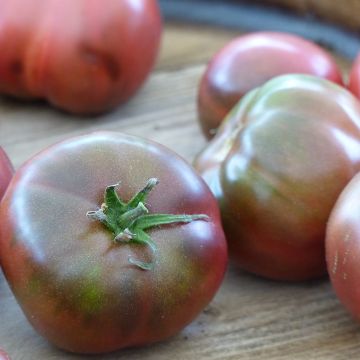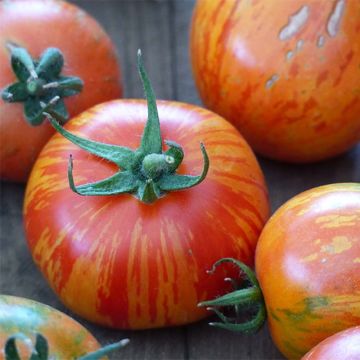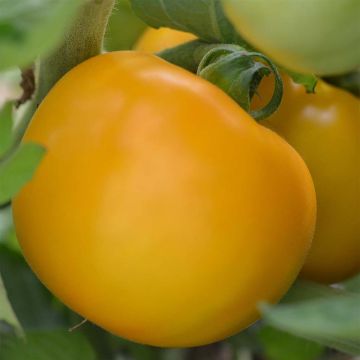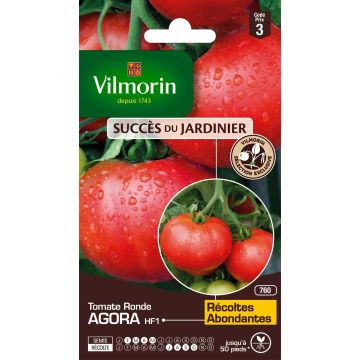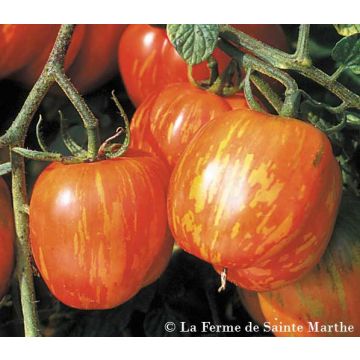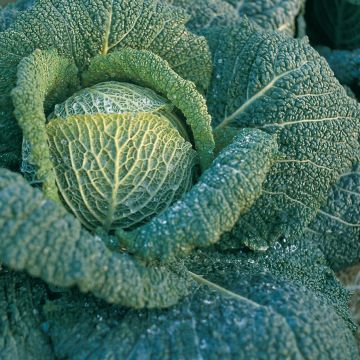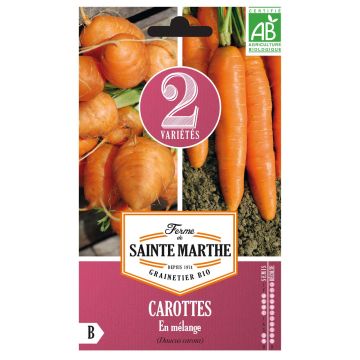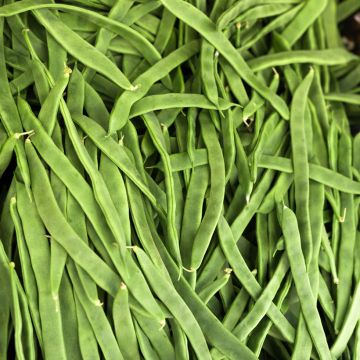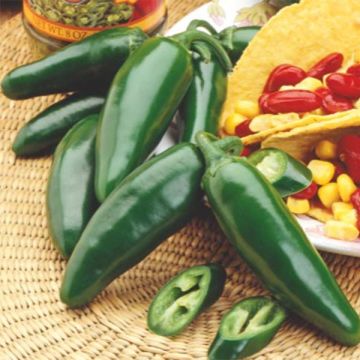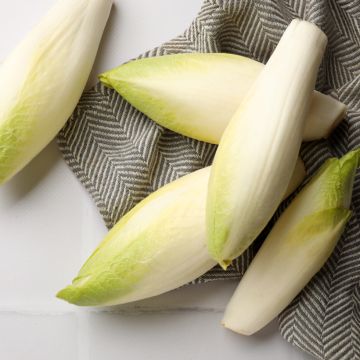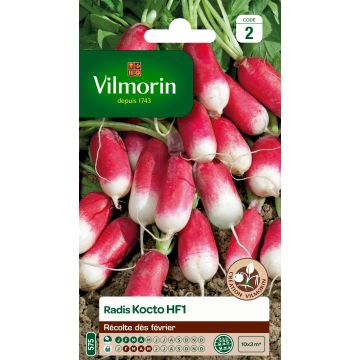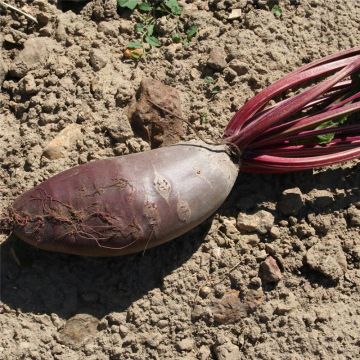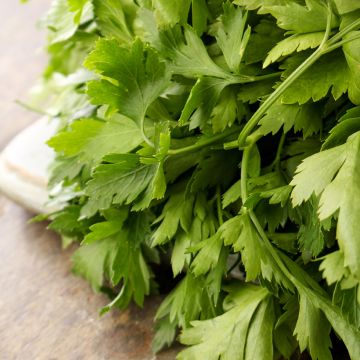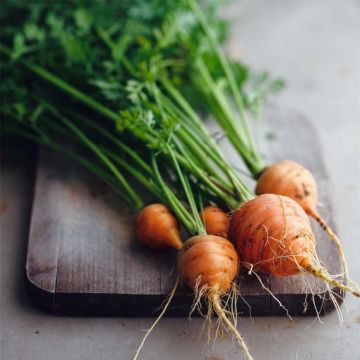Shipping country and language
Your country of residence may be:
Your country of residence is:
For a better user experience on our website, you can select:
Your shipping country:
Andorra
Austria
Belgium
Bulgaria
Canada
Chile
Croatia
Cyprus
Czechia
Denmark
Estonia
Finland
France
Germany
Greece
Hungary
Iceland
Ireland
Italy
Latvia
Lithuania
Luxembourg
Malta
Monaco
Netherlands
Poland
Portugal
Romania
Slovakia
Slovenia
Spain
Sweden
Switzerland
United Kingdom
We only deliver seed and bulb products to your country. If you add other products to your basket, they cannot be shipped.
Language:
French
German
Spanish
English
My Account
Hello
My wish lists
Plantfit
Log in / Register
Existing customer?
New customer?
Create an account to track your orders, access our customer service and, if you wish, make the most of our upcoming offers.


Jaune Saint Vincent Organic Seeds - Ferme de Sainte Marthe seeds
Jaune Saint Vincent Organic Seeds - Ferme de Sainte Marthe seeds
Solanum lycopersicum Jaune Saint Vincent
Tomato
Order in the next for dispatch today!
Dispatch by letter from €3.90.
Delivery charge from €5.90 Oversize package delivery charge from €6.90.
More information
This item is not available in your country.
Schedule delivery date,
and select date in basket
This plant carries a 6 months recovery warranty
More information
We guarantee the quality of our plants for a full growing cycle, and will replace at our expense any plant that fails to recover under normal climatic and planting conditions.
Seed-only orders are dispatched by sealed envelope. The delivery charge for seed-only orders is €3.90.
Description
La Tomate Jack White est une variété issue du croisement entre les variétés White Beauty et White Tomesol. Elle produit de très gros fruits blanc ivoire à blanc crème qui ont la réputation d'être les plus savoureux parmi les tomates blanches. A la fois acides et sucrés, ils présentent une saveur riche et complexe. Ronds et aplatis aux sommets, les fruits sont fortement côtelés aux épaules et ont une attache pédonculaire creusée et un ombilic très marqué. Avec sa belle chair de type beefsteak, on utilisera la Tomate Jack White pour les coulis, les jus ou les farcis. Incorporez-la à une salade multicolore pour y introduire une note de blanc. Les fruits pèsent généralement de 300 g à 1 kg. Pour la découvrir, effectuez vos semis de mars à avril pour une récolte de juillet à octobre.
La tomate est originaire d'Amérique du Sud et d'Amérique centrale. Plusieurs variétés étaient déjà cultivées par les Incas bien avant l'arrivée des Conquistadors. On reste toujours surpris par le foisonnement variétal de cette solanacée. Le terme « tomate » vient de l'Incas Tomatl et désigne à la fois la plante et le fruit issu de la plante. Des fruits, il en existe de toutes les couleurs (rouges, bien sûr mais aussi verts, jaunes et même quelques variétés très rares, bleues), de toutes les formes et de tous les gabarits. Les variétés anciennes sont des plantes à croissance indéterminée et peuvent vivre deux ans. Les variétés plus récentes sont de croissance dite déterminée et arrêtent de grandir au stade du buisson de telle sorte qu'il n'est pas besoin de les tuteurer ni de les palisser.
La tomate fait partie de ces nombreux aliments qui nous sont venus du Nouveau Monde à l'instar du haricot, du maïs, des courges, des pommes de terre, du piment. Elle fut notablement plus longue à atteindre nos papilles. Et pour cause ! Longtemps on la cultiva pour ses qualités esthétiques et médicinales. On la pensait toxique à cause de sa ressemblance avec le fruit de la Mandragore, une autre solanacée. Elle ne devient une habituée de nos tables qu'à partir du début du XXème siècle.
Le plant de tomate est une herbacée vivace en climat tropical cultivée comme une annuelle sous nos latitudes. Elle se lignifie avec le temps et produit de petites fleurs jaunes insignifiantes rassemblées en cymes qui se transformeront en fruits.
Il faut bien admettre que son fruit est très joli et colore agréablement le potager. Il présente aussi de nombreux atouts nutritifs. Peu calorique comme la plupart des légumes, riche en eau, il renferme notamment une molécule très intéressante : le lycopène, un puissant antioxydant. Et plus la tomate cuit longtemps et plus elle en rend disponible. Elle se distingue aussi par sa richesse en vitamine C, provitamine A et en oligo-éléments.
Aujourd'hui ses qualités gustatives et nutritionnelles ne sont plus à démontrer. Pour le jardinier, la tomate figure parmi les légumes incontournables de l'été. Il aura simplement à se demander qu'elle est l'utilisation qu'il souhaite en faire pour se guider parmi toutes les variétés existantes. Est-ce pour en faire des salades, des sauces, pour consommer directement sur place, cuites, etc. Il se demandera aussi à quel moment il souhaite la récolter. La réponse sera bien-sûr conditionnée par l'ensoleillement estival moyen de la région où se trouve son jardin. Qu'on se rassure, le choix est vaste et toute situation a sa tomate ! Et si en effet, la tomate a besoin de beaucoup de soleil, de beaucoup de chaleur elle ne nécessite pas forcément beaucoup de place. C'est pourquoi, il ne faut pas se priver de la cultiver en bac sur son balcon où l'on privilégiera les variétés à petits fruits. Attention, les fruits immatures, les tiges et les feuilles contiennent de la solanine et ne doivent pas être consommés.
La récolte : selon les variétés, de précoces à tardives il peut se passer 50 à 100 jours entre la date de repiquage et la récolte. Il n'existe pas d'astuce permettant à coup sûr de dire a priori qu'une tomate a atteint son murissement complet. La cueillette s'effectuera quand, a minima, elle se pare complètement de la couleur avec laquelle elle a été annoncée et lorsque sa texture, tout en restant ferme, montre un léger ramollissement. Vous prendrez soin, pour une meilleure conservation, de cueillir le fruit surmonté de son pédoncule.
La conservation : les tomates se conservent moins longtemps que leur teneur en eau est élevée. Elles se maintiennent bien quelques jours dans le bac à légumes de votre réfrigérateur ou étalée à l'air libre. Pour les garder plus longtemps, on envisagera des méthodes culinaires comme les confits de tomates, les tomates séchées, les sauces, les fruits congelés, les conserves, les confitures ou les jus. On adore les confire car c'est tout simple et tellement savoureux : coupez vos tomates en deux récoltez-en le jus. Positionnez vos demies tomates face vers le haut, sur le lèchefrite de votre four. Salez, poivrez, sucrez puis enfournez à thermostat très doux pendant une heure au moins. Retirez vos tomates et consommez immédiatement sinon réservez-les dans un bocal en verre et ajustez en huile d'olive.
Le petit truc du jardinier : il est conseillé de cultiver plusieurs variétés de tomates chaque année afin de minimiser les risques de perte complète de récolte qui seraient liés à un aléa climatique ou à une pathologie particulière.
Afin de pallier le phénomène de 'cul noir de la tomate' - n'est pas une maladie mais une carence en calcium - pulvérisez une macération de consoude riche en calcium sur vos plants.
Lors du repiquage, n'hésitez pas à enterrer le pied jusqu'aux premières feuilles. Ceci aura pour effet de stimuler le système racinaire, gage d'une belle récolte en fruits.
Les associations gagnantes au jardin sont souvent les mêmes dans l'assiette. C'est un bon moyen mnémotechnique pour se souvenir que la tomate et le basilic font bonne route ensemble.
Harvest
Plant habit
Foliage
Botanical data
Solanum
lycopersicum
Jaune Saint Vincent
Solanaceae
Tomato
Cultivar or hybrid
Annual
Other Tomato seeds
Planting and care
Soil preparation: tomato plants are very easy to grow and, providing they have enough sun and warmth, will give good results. They do well in most types of soil even if they prefer it to be well-drained and rich. If your soil is too compact you can amend it with a little sharp sand.
Sowing indoors: from mid-February to May, sow indoors or in trays in a greenhouse heated to about 20°C. Cover the seeds with 5 to 7 mm of special sowing mix (they need full darkness to germinate). Don't be tempted to add compost yet as this could burn the young roots. Tomato plants grow quickly: by about two weeks you will see the first seedlings appear. If they haven't appeared by the end of the second week, don't worry, some varieties take longer to germinate. When the seedlings have reached about 15 cm in height, they are ready to be transplanted.
Transplanting straight into the garden: once frosts are no longer to be feared (usually by mid-May), transplant the seedlings straight into the garden. Choose the sunniest and warmest spot in the garden, the foot of a south-facing wall is perfect. Loosen the soil and then dig a hole at least 3 to 4 times the size of your plant's root ball. Add a small amount of well-decomposed compost to the bottom of the hole and mix it in with the garden soil. Place the seedling in the hole and cover it with soil up to the first set of leaves. Gently firm the soil around the roots with your hands and form a shallow soil basin around the base of the seedling. Water copiously at first, making sure you don't wet the leaves in order to protect your plants from fungal diseases.
Maintenance: covering the base of your plants with mulch helps to maintain moisture in the soil whilst keeping the weeds under control. Tomato plants do not need much watering as they send their roots deep into the soil to find moisture. Only in a case of prolonged drought should they be watered copiously.
Seedlings
Care
Intended location
This item has not been reviewed yet - be the first to leave a review about it.
Vegetable seeds
Haven't found what you were looking for?
Hardiness is the lowest winter temperature a plant can endure without suffering serious damage or even dying. However, hardiness is affected by location (a sheltered area, such as a patio), protection (winter cover) and soil type (hardiness is improved by well-drained soil).

Photo Sharing Terms & Conditions
In order to encourage gardeners to interact and share their experiences, Promesse de fleurs offers various media enabling content to be uploaded onto its Site - in particular via the ‘Photo sharing’ module.
The User agrees to refrain from:
- Posting any content that is illegal, prejudicial, insulting, racist, inciteful to hatred, revisionist, contrary to public decency, that infringes on privacy or on the privacy rights of third parties, in particular the publicity rights of persons and goods, intellectual property rights, or the right to privacy.
- Submitting content on behalf of a third party;
- Impersonate the identity of a third party and/or publish any personal information about a third party;
In general, the User undertakes to refrain from any unethical behaviour.
All Content (in particular text, comments, files, images, photos, videos, creative works, etc.), which may be subject to property or intellectual property rights, image or other private rights, shall remain the property of the User, subject to the limited rights granted by the terms of the licence granted by Promesse de fleurs as stated below. Users are at liberty to publish or not to publish such Content on the Site, notably via the ‘Photo Sharing’ facility, and accept that this Content shall be made public and freely accessible, notably on the Internet.
Users further acknowledge, undertake to have ,and guarantee that they hold all necessary rights and permissions to publish such material on the Site, in particular with regard to the legislation in force pertaining to any privacy, property, intellectual property, image, or contractual rights, or rights of any other nature. By publishing such Content on the Site, Users acknowledge accepting full liability as publishers of the Content within the meaning of the law, and grant Promesse de fleurs, free of charge, an inclusive, worldwide licence for the said Content for the entire duration of its publication, including all reproduction, representation, up/downloading, displaying, performing, transmission, and storage rights.
Users also grant permission for their name to be linked to the Content and accept that this link may not always be made available.
By engaging in posting material, Users consent to their Content becoming automatically accessible on the Internet, in particular on other sites and/or blogs and/or web pages of the Promesse de fleurs site, including in particular social pages and the Promesse de fleurs catalogue.
Users may secure the removal of entrusted content free of charge by issuing a simple request via our contact form.
The flowering period indicated on our website applies to countries and regions located in USDA zone 8 (France, the United Kingdom, Ireland, the Netherlands, etc.)
It will vary according to where you live:
- In zones 9 to 10 (Italy, Spain, Greece, etc.), flowering will occur about 2 to 4 weeks earlier.
- In zones 6 to 7 (Germany, Poland, Slovenia, and lower mountainous regions), flowering will be delayed by 2 to 3 weeks.
- In zone 5 (Central Europe, Scandinavia), blooming will be delayed by 3 to 5 weeks.
In temperate climates, pruning of spring-flowering shrubs (forsythia, spireas, etc.) should be done just after flowering.
Pruning of summer-flowering shrubs (Indian Lilac, Perovskia, etc.) can be done in winter or spring.
In cold regions as well as with frost-sensitive plants, avoid pruning too early when severe frosts may still occur.
The planting period indicated on our website applies to countries and regions located in USDA zone 8 (France, United Kingdom, Ireland, Netherlands).
It will vary according to where you live:
- In Mediterranean zones (Marseille, Madrid, Milan, etc.), autumn and winter are the best planting periods.
- In continental zones (Strasbourg, Munich, Vienna, etc.), delay planting by 2 to 3 weeks in spring and bring it forward by 2 to 4 weeks in autumn.
- In mountainous regions (the Alps, Pyrenees, Carpathians, etc.), it is best to plant in late spring (May-June) or late summer (August-September).
The harvesting period indicated on our website applies to countries and regions in USDA zone 8 (France, England, Ireland, the Netherlands).
In colder areas (Scandinavia, Poland, Austria...) fruit and vegetable harvests are likely to be delayed by 3-4 weeks.
In warmer areas (Italy, Spain, Greece, etc.), harvesting will probably take place earlier, depending on weather conditions.
The sowing periods indicated on our website apply to countries and regions within USDA Zone 8 (France, UK, Ireland, Netherlands).
In colder areas (Scandinavia, Poland, Austria...), delay any outdoor sowing by 3-4 weeks, or sow under glass.
In warmer climes (Italy, Spain, Greece, etc.), bring outdoor sowing forward by a few weeks.
